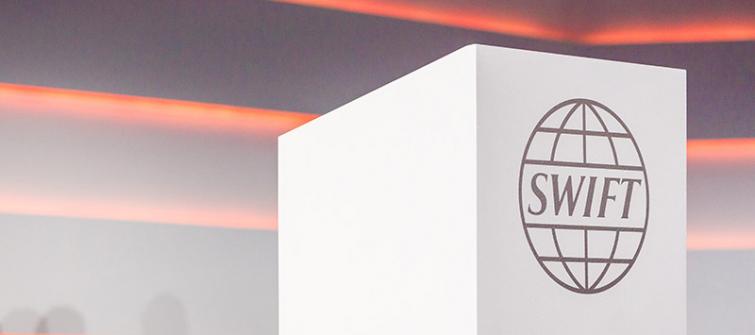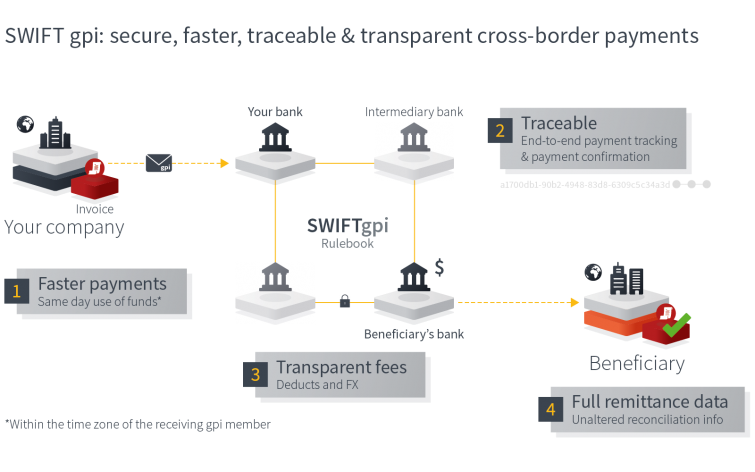SWIFT gpi: Innovation in Global Banking

Inscrutable networks of banks and reference banks for processing cross-border payments stand in the way of treasurers achieving efficiency and transparency. The SWIFT gpi (global payments innovation) project addresses this issue by offering a new and fast method for processing and tracking payments. Information about banks and financial institutions involved, transfer and crediting times, reference IDs as well as specific fees is available in real time. We take a closer look at the project: Where do we currently stand? How does an integrated solution benefit treasury? And how will this innovation impact treasury?
Challenges in cross-border payments
Cross-border payments usually pass through several banks until the funds have been transferred from the payer to the account of the beneficiary. This is referred to as correspondent banking. This results in four obstacles that are virtually insurmountable for treasurers as things stand today:
1) Time: Traditional cross-border payment orders can take several days from being released to being credited – way too long for efficient cash management.
2) Transparency: Several correspondent banks can act as intermediaries between the bank initiating the payment and the beneficiary bank – an impenetrable banking jungle that causes treasurers sleepless nights for security and compliance reasons.
3) Tracking: Today, treasurers neither know where a specific payment is located nor when it will be credited to the beneficiary – an incalculable business risk and a situation that often leads to time-consuming queries, trying to chase a payment.
4) Remittance data: Remittance data is often altered somewhere along the line or information is lost. Sometimes the amount eventually credited to the account does not match the initial payment order because correspondent banks have deducted fees, resulting in a tedious reconciliation process once the money has arrived.
SWIFT global payments innovation – SWIFT gpi
In January 2017, SWIFT introduced the gpi Service that can be used to process global payments in a fast and traceable manner. The objective is for every one of the around 10,000 SWIFT Network banks to be able to offer money transfers within 24 hours with continuous end-to-end tracking and complete transparency along the entire payment chain by the end of 2020. This transparency and efficiency is made possible by using a specific gpi reference, the Unique End-to-End Transaction Reference UETR.

How the Unique End-to-End Transaction Reference (UETR) works
You can compare the UETR to the tracking number of a parcel: The sender issues a unique, unalterable reference that shows you where the order is located at any one time. This reference ensures complete transparency as well as fully digitized and therefore speedy processing. In addition, the sender is automatically notified of any payment status changes. Conventional transfers often drop off the radar for quite some time, and you’re left wondering where your money has gone, not to mention the effort it will take you to retrace and reconcile afterwards. Conversely, gpi transfers generate an abundance of messages that keep you up to date on the status of your payment.
The same applies to the respective bank departments who can also trace corporate payments, enabling them to react to queries much faster. Some banks have integrated functionality in their online banking applications that enables corporate clients to track their gpi payments. Not a bad idea – the only downside is that most corporates use more than one bank for their international payments, which would mean checking several banking portals. This is why a bank-independent treasury management system such as Coupa Treasury is a much more elegant solution. All tracking and status information converges in one centralized hub, no matter how many banks are involved.
SWIFT gpi for Corporates – new dynamic and transparency in treasury
In November 2018, SWIFT launched the SWIFT gpi for Corporates project in order to enable corporates to directly benefit from the gpi technology. The objective was to offer corporates a solution for initiating gpi payment orders directly in their payments system.
What does this mean for banks and companies?
The role of banks
Banks must be able to process certain information in order for it to be included in gpi payment orders. More than 280 financial institutions worldwide, including 49 of the TOP 50 banks, have agreed on a standardized SLA. With so many banks participating, communication is guaranteed. i.e. funds are transferred quickly from one bank to the next. By now, most banks have started processing cross-border payments as gpi payments.
The role of companies
The UETR is crucial for processing gpi payments. Companies that initiate their own payments, for example through a treasury management system integrated payment solution need to attach this reference to a payment order in line with SWIFT requirements or extend the format of a payment in the right place to include this information. The information transmitted by way of the UETR simplifies reconciliation and can be matched automatically, depending on the system.
Coupa Treasury offers integrated SWIFT gpi for Corporates technology
Coupa Treasury offers integrated SWIFT gpi technology. The system generates the unique and unalterable tracking reference UETR that is required for gpi payments. In addition, Coupa Treasury automatically processes incoming gpi status messages, enabling users to check the status of a payment at any time.
Corporates need a SWIFT BIC (Business Identifier Code) to make use of SWIFT gpi for Corporates technology. They register their BIC for gpi for Corporates and connect financial institutions that offer gpi for Corporates. All in all, SWIFT gpi for Coprorates unlocks completely new opportunities for automating treasury processes, in turn leading to efficiency gains and increased security.
How will gpi change treasury?
gpi is fast, creates transparency regarding fees and currencies and provides a wealth of information about the location of a payment and other aspects that simplify reconciliation. The SWIFT gpi initiative is clear evidence that corporate payments are moving towards real-time processing. In turn, this will change processes and the way treasurers work.
Recommendations for treasurers
Treasurers should take note:
- With liquid funds easier to locate and timely confirmations by beneficiary banks, treasurers must adjust their liquidity plans
- Transparent fees are a solid basis for negotiating with banks, something that might influence a company’s banking strategy
- Quicker access to funds (same-day payments) enables efficiency gains
- Treasurers may be able to say goodbye to delayed payments and any ensuing difficulties
- Increased payment security requirements may mean that this newly found dynamic and transparent nature of cross-border payments will become the benchmark for all other treasury disciplines
Thanks to the SWIFT and Coupa Treasury, treasures are ready for any changes to cross-border payments coming their way. The future is now, let us take you there.
Want to learn more about our powerful treasury solutions? Time to discover Coupa Treasury.